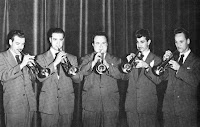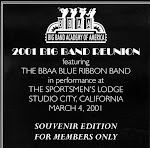On Nov. 10, we posted this photograph that reader Steven Kane had seen on eBay:
The name "Henry Busse" appeared on the back of the photo, but the trumpeter pictured was definitely not Busse. Steven asked if anyone might be able to identify him. Our own Van Alexander of the BBAA board of directors has come to the rescue:
"The man in the photo was a dear friend and fine musician. His name was Truman Quigley. Played in my New York band for quite a time. When I moved to California, he did also. I used him when I put the Bob Crosby band together. He recorded one of my arrangements for the Crosby band, 'I Wish I Could Shimmy Like My Sister Kate.' I knew his wife and parents.
P.S. I have this autographed picture in my gallery."
Van, thanks so much for solving the mystery. We're also pleased to note that Van's autobiography, From Harlem to Hollywood: My Life in Music, has been awarded a Certificate of Merit by the Association for Recorded Sound Collections. ARSC is a non-profit organization dedicated to the preservation and study of sound recordings, in all genres of music and speech, in all formats and from all periods. Congratulations, Van!
*************
We mourn the passing two weeks ago of Roy Reynolds, sax player with Stan Kenton's orchestra. Roy's cousin Barrie Wall wrote the following remembrance, which we are proud to reprint:
Roy Reynolds: A Personal Tribute to a World Class Musician (and a lovely feller)
by Barrie Wall:
Roy’s cousin,
also known by Roy as 'Our Kid'
'We were playing Carnegie Hall. Stan called ‘Roy’s Blues,’ which Dale Devoe had written for me, and I ended up getting a standing ovation. Man, I felt about 50 feet tall.' - Roy Reynolds, featured saxophone soloist with the Stan Kenton Orchestra from 1973 until Stan’s death in 1979
It wasn’t the only standing ovation of Roy’s musical career, nor was it by any means the last. But it was by far the most important and without doubt, the one that left the greatest impression on the then-44-year-old big band musician, a one-time raggedy-assed kid from a blue-collar Birmingham, England suburb.
The effect wasn't just on Roy, but also on the packed Carnegie Hall audience, his band colleagues and the Maestro himself. It was also the moment, or rather, the seven or eight minutes of unaccompanied artistry, sheer brilliance and faultless invention which, after nearly 30 years of journeyman musicianship in both Britain and Canada, justly and deservedly placed him in the front rank of world-class jazz performers.
Roy wasn’t the first jazz musician to bring the Carnegie house down. Some 35 years earlier, legendary band leader and clarinetist Benny Goodman - an early Reynolds idol and inspiration - had been there with the landmark 1938 Carnegie Hall concert. Although he played both tenor sax and clarinet with equal acuity, and because Kenton didn’t care for clarinets, Reynolds’ main focus by that time was tenor sax, the instrument for which he was better known during his U.S. and Canadian career.
Like most overnight successes, however, Roy’s was a long time coming. His early attempts at music-making began around the age of 14 with an aging clarinet and the few lessons his parents could afford. As soon as he could legally, he applied to enlist as a band boy in the British Army’s Norfolk Regiment. After hearing him struggle through some scales, the kindly bandmaster advised Roy to go home and 'practice some more; come back when you’re a man.' (In those days, there was a distinction between the British Army’s Boys’ Service and Man’s Service, which began when entrants reached the age of 18.)
More determined than ever, he did just that. Recognizing that his best hope for a free musical education lay with the military, Roy auditioned in response to a ‘Musicians Wanted’ advertisement in the local newspaper and was accepted shortly before his 18th birthday as a bandsman in the 42nd Royal Highland Regiment: The Black Watch.
A five-year engagement, with virtually seven-day-a-week practices, rehearsals and global performances, ensured that the now-kilted and sporraned ‘Highlander’ (with the broad and unmistakable Birmingham accent he never lost) began paying his musical dues. He emerged five years later as a talented clarinet, saxophone and flute player.
Roy Reynolds and the Black Watch bandmasters of the day didn’t always agree on band policy and what constituted serious practice. Although two or three bandmasters/musical directors came and went during Roy’s Black Watch tenure, one in particular was given to patrolling the barrack building corridors at night to ensure his charges were practicing set pieces or scales. He wasn’t impressed when, with an ear to the keyhole, he heard Roy practicing Artie Shaw’s Clarinet Concerto. As Reynolds recalls, relations thereafter became strained.
Despite an abiding and continuing nostalgia for his Black Watch band years, by 1952 Reynolds was a regular visitor to Archer Street in Soho, London’s main venue and talent exchange for work-seeking freelance musicians. Against the odds - the talent pool was large and paying work scarce - he survived those crucial formative years, never gave up on his chosen career and, because of his even-then obvious talent, made a professional if not lucrative living with a number of notable British bands and jazz groups. Among those were the Ken Mackintosh band, the Squadronaires, Joe Daniels' Hot Shots, Eddie Mendoza’s comedy Dixieland band and the Carl Barriteau swing band. West Indian Barriteau’s original all-black U.K. big band was effectively wiped out while playing a wartime gig at London’s Café de Paris.
In a sense, it was a chance meeting in Archer Street in 1965 that led Roy to Canada and the Stan Kenton Orchestra. Back in Britain, vacationing former Black Watch flutist/tenor man Cliff Hails suggested Roy sign up, as Cliff had done, with the Canadian army, which was seeking qualified musicians. The stable income, decent living conditions and opportunities offered were enough to convince Roy to follow suit. Soon after, he found himself wearing the uniform of Lord Strathcona’s Horse Regiment in Calgary, Alberta. The Strathconas subsequently merged with Princess Patricia’s Canadian Light Infantry, which led to Roy being selected for the Ottawa-based Central Band of the Canadian Armed Forces.
When his military time expired, aside from jazz club gigs, cruise-ship bands, weddings, Bar Mitzvahs, and whatever other work he could pick up, Roy’s core income came from the house band of Ottawa’s Skyline Hotel. The diminished income from playing compelled Roy to take a part-time job teaching high school music students. However, this led to a pivotal 1972 encounter with Kenton band members and ultimately Stan himself. After hearing Roy play, Stan asked him if he’d like to join the band.
Of course, there were minor obstacles to be negotiated, such as work permits. The U.S. apparently had as many saxophonists as it needed, but after describing himself as a 'saxophonist/composer,' Roy was approved and began a gruelling yet artistically rewarding career with the Stan Kenton orchestra.
For the next seven years, Roy and the band were on the road worldwide for 48 weeks out of every 52. They visited practically every state in the union, as well as Britain, Germany, Holland, Italy, Sweden, Denmark, Japan and, of course, a return visit to Canada and Vancouver’s Commodore Ballroom in 1976.
On Stan’s death in 1979 following a stroke, Roy decided to settle in Vancouver. To help launch him, a long-lost cousin arranged a month of 4:00-8:00 p.m. gigs on Thursdays at Annabelle's disco room in the Four Seasons Hotel. The appeal to the hotel’s jazz-loving general manager Peter Martin was obvious: The disco was normally dark during those hours. Besides, the Reynolds quartet/quintet and guests generated steady bar revenue, and almost immediately, Annabelle's became the place to be after work on Thursdays.
'The first time I heard Roy play, I knew he was special. When playing a normal gig, he played to his audience. In concert, he seemed to play to the universe. He breathed life into every note and electrified the room. How he has escaped becoming a household word among the all time greats I will never know. He has moved me to simultaneous tears and laughter for the sheer joy of it. Perhaps it is because he leaves the stage in graceful modesty, unaware of his own genius.' - Chris Fredrickson, former bassist/pianist, Vancouver Hot Jazz Club
Some of the talented early stalwarts at Annabelle’s were luminaries like guitarist Oliver Gannon, vibist Elmer Gill, bassists Torben Oxbol and Wyatt Ruther, drummer Blaine Wikjord and a host of others who combined to produce some of the most exciting jazz the city had heard in years. Those players aside, Annabelle’s also provided opportunities for talented young instrumentalists and singers to sit in. Among them was Vancouver-born pianist Renee Rosnes, who left for New York’s Juilliard School in the mid-'80s and is now a star in her own right.
' ... the consummate musician and a man with a genuinely soft heart.' - Bob Cadwallader, Trombonist, Victoria, B.C.
When Annabelle’s closed its doors, the Roy Reynolds show moved to the neighbouring Georgia Hotel with equal success and later to a Hastings Street restaurant bar. Wherever the band went, its loyal fans followed ... until, inevitably, it was time to call it a day.
For the past 16 years, Roy lived in Victoria, continuing to play jazz in a variety of capital venues and lending his talents to community bands and orchestras, such the city’s Swiftsure Big Band. As near-total hearing loss gradually lessened Roy's tolerance for loud band music, he segued into a clarinet role with Victoria’s Hampton Community Orchestra.
'I used to play trumpet in the Swiftsure Big Band and had the opportunity to play with Roy on a few occasions. He’s great to work with, a wonderful person and musician. I’ve never heard such a huge sound come out of a tenor sax.' - Alfons Fear, Victoria, B.C.
Roy gave up playing in October of this year at age 81 after being diagnosed with lung cancer. Following a difficult final rehearsal with the Hampton orchestra, Roy resigned emotionally from the group, mainly, as he put it, 'because I no longer had the breath or the hearing to continue.'
For the first time in more than 65 years of distinguished music-making, Roy’s horns are now silent. Roy died peacefully at about 4:30 a.m on Sunday, Nov. 28, with fellow musician and his companion of 16 years, Val Turner, at his side.
Roy's saxophone and clarinet will remain in the family, perhaps to be played again at some point in the future by an 11-year-old great-niece who recently began studying alto sax in elementary school.
The final word on Roy comes from former Kenton trumpet player Mike Vax:
'You are one of the truly good guys! I’ve valued our friendship over the years and have loved every minute that I got to perform with you. It seems hard to believe that we first played together almost 40 years ago. I know that Stan loved you, as did all the guysyou performed with the Kenton orchestra.'
Many thanks, Barrie. And rest well, Roy.



































.bmp)
.jpg)




